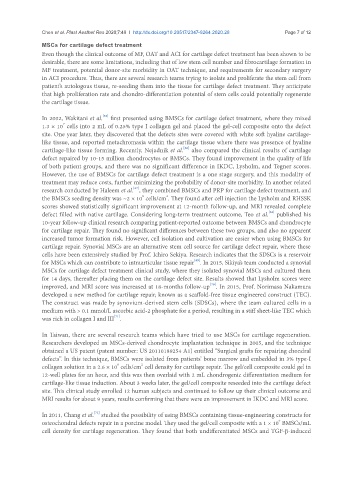Page 569 - Read Online
P. 569
Chen et al. Plast Aesthet Res 2020;7:49 I http://dx.doi.org/10.20517/2347-9264.2020.28 Page 7 of 12
MSCs for cartilage defect treatment
Even though the clinical outcome of MF, OAT and ACI for cartilage defect treatment has been shown to be
desirable, there are some limitations, including that of low stem cell number and fibrocartilage formation in
MF treatment, potential donor-site morbidity in OAT technique, and requirements for secondary surgery
in ACI procedure. Thus, there are several research teams trying to isolate and proliferate the stem cell from
patient’s autologous tissue, re-seeding them into the tissue for cartilage defect treatment. They anticipate
that high proliferation rate and chondro-differentiation potential of stem cells could potentially regenerate
the cartilage tissue.
[65]
In 2002, Wakitani et al. first presented using BMSCs for cartilage defect treatment, where they mixed
7
1.3 × 10 cells into 2 mL of 0.25% type I collagen gel and placed the gel-cell composite onto the defect
site. One year later, they discovered that the defects sites were covered with white soft hyaline cartilage-
like tissue, and reported metachromasia within the cartilage tissue where there was presence of hyaline
cartilage-like tissue forming. Recently, Nejadnik et al. also compared the clinical results of cartilage
[66]
defect repaired by 10-15 million chondrocytes or BMSCs. They found improvement in the quality of life
of both patient groups, and there was no significant difference in IKDC, Lysholm, and Tegner scores.
However, the use of BMSCs for cartilage defect treatment is a one stage surgery, and this modality of
treatment may reduce costs, further minimizing the probability of donor-site morbidity. In another related
[67]
research conducted by Haleem et al. , they combined BMSCs and PRP for cartilage defect treatment, and
2
6
the BMSCs seeding density was ~2 × 10 cells/cm . They found after cell injection the Lysholm and RHSSK
scores showed statistically significant improvement at 12-month follow-up, and MRI revealed complete
[68]
defect filled with native cartilage. Considering long-term treatment outcome, Teo et al. published his
10-year follow-up clinical research comparing patient-reported outcome between BMSCs and chondrocyte
for cartilage repair. They found no significant differences between these two groups, and also no apparent
increased tumor formation risk. However, cell isolation and cultivation are easier when using BMSCs for
cartilage repair. Synovial MSCs are an alternative stem cell source for cartilage defect repair, where these
cells have been extensively studied by Prof. Ichiro Sekiya. Research indicates that the SDSCs is a reservoir
for MSCs which can contribute to intraarticular tissue repair . In 2015, Sikiya’s team conducted a synovial
[69]
MSCs for cartilage defect treatment clinical study, where they isolated synovial MSCs and cultured them
for 14 days, thereafter placing them on the cartilage defect site. Results showed that Lysholm scores were
[70]
improved, and MRI score was increased at 18-months follow-up . In 2015, Prof. Norimasa Nakamura
developed a new method for cartilage repair, known as a scaffold-free tissue engineered construct (TEC).
The construct was made by synovium-derived stem cells (SDSCs), where the team cultured cells in a
medium with > 0.1 mmol/L ascorbic acid-2 phosphate for a period, resulting in a stiff sheet-like TEC which
[71]
was rich in collagen I and III .
In Taiwan, there are several research teams which have tried to use MSCs for cartilage regeneration.
Researchers developed an MSCs-derived chondrocyte implantation technique in 2005, and the technique
obtained a US patent (patent number: US 20110189254 A1) entitled “Surgical grafts for repairing chondral
defects”. In this technique, BMSCs were isolated from patients’ bone marrow and embedded in 3% type-I
6
2
collagen solution in a 2.6 × 10 cells/cm cell density for cartilage repair. The gel/cell composite could gel in
12-well plates for an hour, and this was then overlaid with 2 mL chondrogenic differentiation medium for
cartilage-like tissue induction. About 3 weeks later, the gel/cell composite reseeded into the cartilage defect
site. This clinical study enrolled 12 human subjects and continued to follow up their clinical outcome and
MRI results for about 9 years, results confirming that there were an improvement in IKDC and MRI score.
[72]
In 2011, Chang et al. studied the possibility of using BMSCs containing tissue-engineering constructs for
6
osteochondral defects repair in a porcine model. They used the gel/cell composite with a 1 × 10 BMSCs/mL
cell density for cartilage regeneration. They found that both undifferentiated MSCs and TGF-β-induced

